SEO
How to Completely Optimize Your GMB Listing

Google Business Profile is a free feature from Google that helps business owners manage their online presence across the search engine and its growing portfolio of utilities, including Google Maps.
Seasoned SEO professionals use Google Business Profiles to leverage a location-based strategy.
Creating a Google Business Profile is the first step to local search success.
And for good reason.
GBP offers the greatest impact for brands seeking local exposure.
A feature like Google’s Local Search emphasizes the need for a GBP for both new and established businesses.
Google Business Profiles: The Basics
It gives a list of businesses nearby and a lot of information needed to find a specific business like:
- Business address.
- Business hours.
- Category.
- Reviews.
Google’s Knowledge Graph also utilizes verified Google Business Profile information.
It helps generate details for its database about businesses and related entities that are relevant to specific searches.
Once a new profile is created, a Google Maps location is then generated.
That synchronizes with traditional Google Search for ease of access and searchability.
It certainly helps that the clear majority of organic searches come from Google – around 90% for worldwide search engine market share.
It also shows the value of a GBP and effective local SEO.
Use this guide to ensure you’ve completed your Google Business Profile correctly and optimized all possible facets of the tool.
Doing this will also give the most leverage for your business on Google and third-party platforms that use the Google Maps API to generate location information for users.
If digital marketing is a somewhat new endeavor for you and your business, there are some basics to know.
And it’s good to understand Google Business Profiles and the value they offer.
First off: Yes, using Google Business Profile is free.
And, no, a GBP doesn’t replace your business’s website.
Google Business Profiles complement a brand’s already-existing website(s) by giving it a public identity and presence with a profile on Google.
The information provided about a business through Google Business Profiles can appear in Google Search and Google Maps.
Any third-party platform utilizing the Google Maps API will also show Google Business Profiles regardless of what device type is being used to search.
If you’ve previously used certain Google tools to complement your business (Google+, for example), or your business has been operating for a while, chances are your business is already listed on Google Business Profiles.
Google My Business, Google Places for Business, and the Google+ Pages Dashboard were the best ways to manage your business information previously.
These have automatically been upgraded to Google’s universal platform, Google Business Profiles.
Starting Your Google Business Profile
The first step to getting your Google Business Profile up and running is to actually conduct a Google search to ensure your business doesn’t already have one.
You can also use Google’s in-platform search feature to locate your business on GBP.
 Screenshot from Google Business Profile Manager, September 2020
Screenshot from Google Business Profile Manager, September 2020If your business has been around for a while (several years or more), it’s likely it already has a GBP, and you just need to claim it.
Once successfully claimed, you can manage the information as if you started the GBP yourself.
If there is already a profile for your business, it will notify you.
It may also notify you that someone else has already claimed your business.
If that happens, follow these steps.
If your business profile is not already created, you can set it up pretty quickly.
Verification takes a bit longer to complete, but it can usually get done within a week.
Start with the official business name before inputting more important info. Then input your main business category.
 Screenshot from Google Business Profile Manager, September 2020
Screenshot from Google Business Profile Manager, September 2020You can change and add to this later, but this is a critical part of completing (and optimizing) your brand page.
Be sure to find the best relevant category for your business.
There are a lot of variations to choose from, but there should be at least one that summarizes your business best and most accurately.
You will then be asked if you want to “add a location customers can visit, like a store or office?”
This is valuable information since many businesses operate as service-area businesses and do not need/allow customers at the brick-and-mortar location.
For these instances, the specific location of the business will not show up on Google Maps.
However, the business will still show up for relevant searches in its service area.
 Screenshot from Google Business Profile Manager, September 2020
Screenshot from Google Business Profile Manager, September 2020For those businesses that operate in a specific service area and don’t want the actual brick-and-mortar location to show up in Maps, select the service area(s) that pertain to the business.
 Screenshot from Google Business Profile Manager, September 2020
Screenshot from Google Business Profile Manager, September 2020You can then add contact information for the business, including the contact phone number and the current website URL.
For businesses with that brick-and-mortar location that people can go to during business hours, you should add the business address next.
 Screenshot from Google Business Profile Manager, September 2020
Screenshot from Google Business Profile Manager, September 2020Once the address is set, Google Business Profile will ask if you “also service customers outside this location?”
It lets you set where/how far the business is willing to physically go to deliver goods or services.
If yes, you will be able to walk through the same service-area business details.
You can add or change service area details at any time.
If you don’t service customers outside of the brick-and-mortar, select No, then input contact details on the next prompt.
 Screenshot from Google Business Profile Manager, September 2020
Screenshot from Google Business Profile Manager, September 2020After that, you can then click Next to verify the profile.
Verifying Your Google Business Profile
You need to verify your Google Business Profile.
This is done via postcard by mail, which takes up to five business days.
It proves to Google you can manage and do, in fact, represent the business you claim.
Verifying your business is crucial for the visibility and performance of the profile.
It’s important to know that Google won’t display your business or its edits until the business is verified.
Without verification, you cannot access page insights/analytical information or business reviews from the back end.
Verification typically takes less than a week.
Google will send you a verification code postcard that you will use to verify your profile, and your business will officially be live.
After you confirm the verification method, you can add additional details about your business, including business hours, business messaging options, a business description, and photos.
Publishing Your Google Business Profile
Once you complete this process, you will be taken to Google Business Profile Manager, where you can manage your business profile and modify your details.
Here are some basic but crucial tips for optimizing your profile:
1. Enter Complete Data For Your Profile
Local search results favor the most relevant results for searches.
Businesses offering the most detailed and accurate information will be easier to serve in search.
Don’t leave anything to be guessed or assumed.
Make sure your profile communicates what your business does, where it is, and how they can acquire the goods and/or services your business is offering.
2. Include Keywords
Just like traditional website SEO, Google uses a variety of signals to serve search results.
Including important keywords and search phrases to your business profile will be incredibly helpful, especially since your business website is listed directly within your GBP.
Use these in the business description and each time you post a Local Post to your audience.
3. Keep Business Operating Hours Accurate
It’s important to put your business hours, but it’s equally important to update them whenever they change.
Google offers the ability to customize hours for holidays and other special events.
It should always be updated to keep your site accurate and users happy.
And, in the age of COVID-19, GBP offers even more flexibility around hours and messaging for potential customers.
Note: Additional hours won’t show for your business until regular hours are set.
4. Add Photos
Photos help business profiles’ performance more than most business owners and marketers probably expect.
Businesses with photos on their profiles receive 42% more requests for driving directions on Google Maps and 35% more click-throughs to their websites than businesses without photos, according to Google.
Keep reading for more GBP photo tips below.
5. Manage & Respond To Customer Reviews
Interacting with customers by responding to their reviews illustrates that your business values its customers and the feedback that they leave regarding it.
Positive reviews are going to have a positive effect on potential customers when researching your business.
They also increase your business’s visibility in search results.
Encourage customers to leave feedback by creating a link they can click to write reviews for your business.
6. Let Customers Message You
It can be somewhat inconvenient at times, but messages to and from customers are only available through the Google Business Profile app.
To do so, tap Customers, then Messages, then Turn on through the app.
Once enabled, customers will be able to message businesses through their Business Profiles with the Message button that appears.
Messages can have customized automated responses to welcome customers for incoming messages.
This helps with the responsiveness and visibility of the business since response times won’t suffer as badly.
For maximum performance and visibility through the GBP, it’s critical to keep message response time under 24 hours.
But obviously faster is better.
Customers don’t want to wait for answers, and oftentimes a fast answer is the difference between a customer and a non-customer.
7. Use Local Posts
You can publish offers, events, products, and services directly to Google Search and Maps through posts on Google Business Profiles.
Posts let you engage with your audience and keep your presence fresh on Google.
And they can be sent on the go from either a phone, tablet, or computer.
Businesses can also influence their Knowledge Panel breakouts with direct feedback about their businesses and the people that represent them.
Some Google-provided tips for making the most out of Local Posts are: Make sure each post is high-quality – free of spelling errors, broken characters, gibberish, or useless information.
And they should be respectful and non-offensive.
The best posts include visuals and links, but the links should always be to sites that are trusted.
Links that lead to malware, viruses, phishing, or pornographic material aren’t allowed.
Posts from businesses that operate on regulated goods and services are allowed to use posts but can’t post content related to the products themselves.
These industries typically include:
- Adult services.
- Alcohol and tobacco.
- Pharmaceutical products and recreational drugs.
- Health and medical devices.
- Gambling-related services.
- Fireworks.
- Weapons.
- Financial services.
These posts can and will show up in Google, so they need to be kept PG.
8. Stay Connected During COVID-19
This year has provided us with plenty of surprises. The biggest has been COVID-19 and the craziness it left (and continues to leave) in its wake.
If stores operate differently than normal due to COVID-19 restrictions, mandates, or safety guidelines, businesses can update their profiles on GBP to provide the most accurate information to customers.
Recently added features make communicating with current and potential customers easier in the time of the pandemic.
In addition to customizable business hours and Local Posts, a business can:
- Mark store temporarily closed.
- Manage delivery options.
- Add healthy and safety attributes.
9. Use The Special Attributes
Newer features to GBP allow Black-owned and women-led businesses to be highlighted on their profile.
These also allow for other features like outdoor seating and the like.
If the business is healthcare-related, additional attributes may be available including:
- Inform customers whether your business offers online care.
- Provide customers with a direct method to schedule and receive online care.
- Edit your gender information.
The attributes available to your listing depend on its primary category. Learn more about attributes here.
10. Use The Product Catalog
For merchants with products to showcase, GBP’s Product Editor allows them to do just that.
Most business types are eligible to showcase products, so long as they are small- and medium-sized businesses; and a few business verticals.
Larger businesses need to use Local Inventory Ads to showcase their products.
Offering information about products, including pricing, details, and photos, allows customers to get a better idea of products offered and interact more with businesses.
These product details also allow Google to better understand a business.
Photos & Videos For Your Google Business Profiles
The most important piece of imagery for a GBP is obviously the logo.
There likely won’t be an image that gets more exposure or has more of an impact.
Google recommends businesses use their logo to help customers identify your business with a square-sized image.
Other types of digital assets that should be added to your GBP are:
Cover Photo
Your cover photo should showcase your brand page’s personality.
The cover photo is the large photo featured at the top of the brand’s business profile, it will always be cropped to fit a 16:9 aspect ratio.
Interior Photos
This helps customers better understand the in-store experience at a business.
It lets business operators share the look and feel of the business interior, so make a good impression!
It also lets potential customers get a visual idea of the store, its layout, and any potential limitations it may have.
Video
Videos are one of the most popular media forms on the web.
It’s because they are extremely effective at telling a story and/or explaining something that could otherwise potentially be tough to explain.
Additional Photos
Other kinds of photos are used to spotlight features of your business that customers consider when making purchasing decisions.
These photos will differ from the above-mentioned rich media and are dependent on the kind of business you manage.
These photos may include other general photos that summarize the business and what it can do for its customers.
They can be:
- Goods and/or services your business offers.
- Business staff working and/or assisting customers.
- The exterior of the business and available parking.
All photos should follow Google’s best practices:
- Format: JPG or PNG
- Size: Between 10 KB and 5 MB
- Minimum resolution: 720 px tall, 720 px wide
- Quality: The photo should be in focus and well-lit, and have no alterations or excessive use of filters. The image should represent reality.
Google also offers the opportunity for a Virtual Tour, which will further enhance the brand profile’s visibility.
It can also draw traffic to the business with a 360-degree interactive experience.
Monitoring Your Google Business Profile Insights
Over the last several years, Google has made tremendous strides with available analytical data for Google Business Profiles.
Now called Insights, Google offers businesses a different way to understand how customers interact with business profiles, including:
- How customers find your profile.
- Where customers find you on Google.
- Customer actions.
- Direction requests.
- Phone calls.
How Customers Find Your Profile
This section of Insights shows how customers found you in a “Direct” search (they searched for your business name or address) versus a “Discovery” search (they searched for a category, product, or service that you offer, and your profile appeared).
These sections have the following labels in bulk insights reports:
- Total searches.
- Direct searches.
- Discovery searches.
Where Customers Find You On Google
This section shows how many customers found you via Google Search or Google Maps.
Besides Listing on Search and Listing on Maps, you’ll see the number of views your profile received from each product in the timeframe you’ve selected.
According to Google, “views” are like “impressions” on other analytics platforms.
To see how many people found you on a particular product on a particular day, place your cursor over the appropriate segment of the graph on the day you’re interested in.
These sections have the following labels in bulk insights reports:
- Total views.
- Search views.
- Maps views.
Customer Actions
This section shows what customers did once they found your profile on Google.
Total actions give the total of the following types of actions that customers took on your profile:
- Visit your website.
- Request directions.
- Call you.
- View photos.
The following labels are available as reports in this reporting section:
- Total actions.
- Website actions.
- Directions actions.
- Phone call actions.
- Direction requests.
This part of Insights uses a map to show where people are that are requesting directions to your business.
Your business location is identified on the map and some of the most common spots that people request directions to your business from are shown.
It even breaks the total number of direction requests down by city or neighborhood.
Phone Calls
This section shows when and how often customers called your business via your profile on Google.
At the top of the section, Total calls give the total number of phone calls for the selected time frame.
The graph offers the ability to view trends by phone calls by either day of the week or time of day.
This lets marketers and business operators know when customers are most likely to call after seeing your GBP.
Photos
Lastly, GBP allows you to examine how often your business’s photos are being viewed with the Photo views graph and Photo quantity graph.
There are also lines on the graphs that compare your business’s photo data with photo data for other businesses similar to yours.
Section of this reporting component includes bulk insights for:
- Total owner photos.
- Owner photo views.
- Total customer photos.
- Customer photo views.
Featured Image: Paulo Bobita/Search Engine Journal
SEO
Google Defends Lack Of Communication Around Search Updates
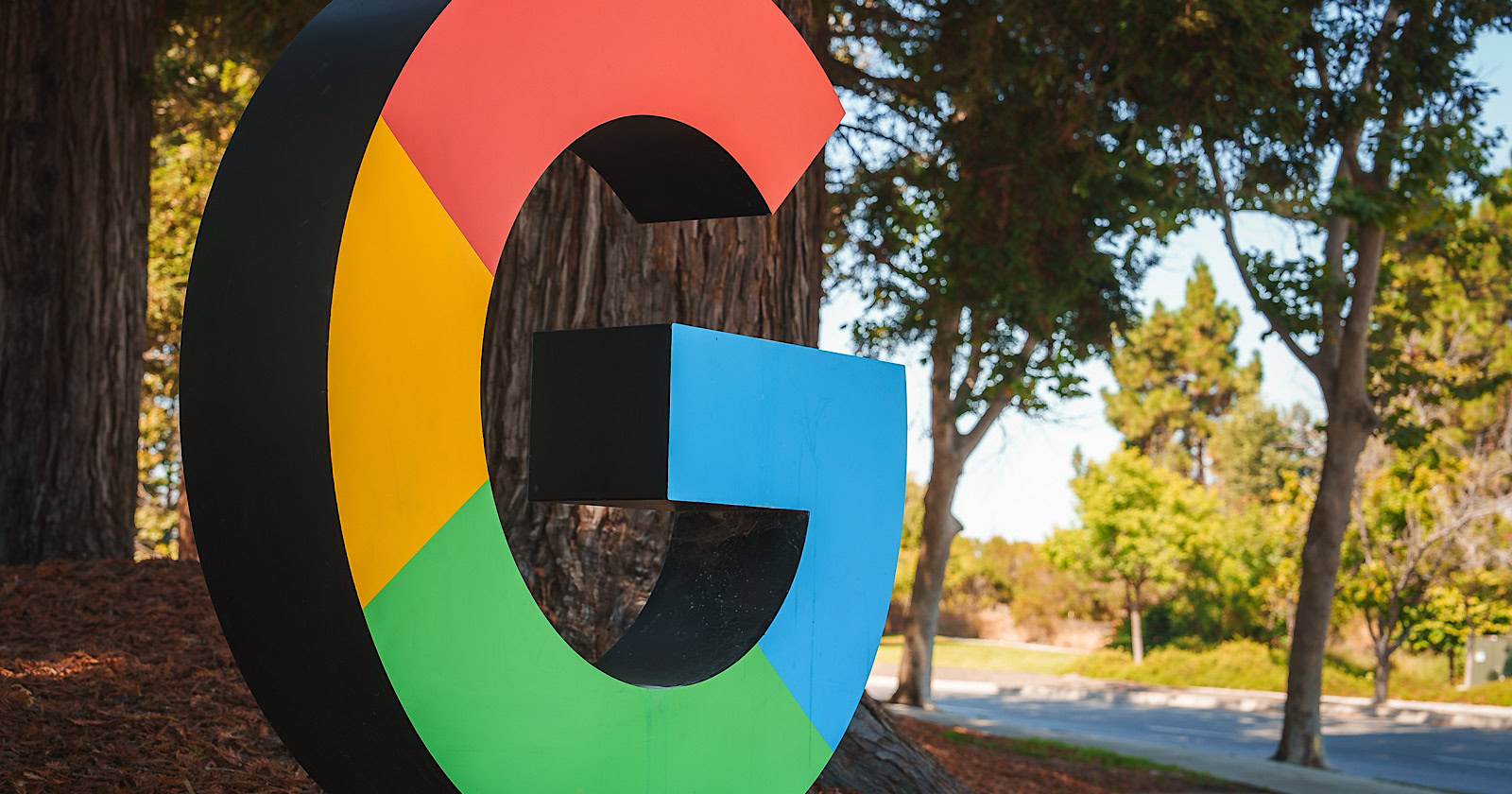
While Google informs the public about broad core algorithm updates, it doesn’t announce every minor change or tweak, according to Google’s Search Liaison Danny Sullivan.
The comments were in response to Glenn Gabe’s question about why Google doesn’t provide information about volatility following the March core update.
OK, I love that Google informs us about broad core updates rolling out, but why not also explain when huge changes roll out that seem like an extension of the broad core update? I mean, it’s cool that Google can decouple algorithms from broad core updates and run them separately… https://t.co/2Oan7X6FTk
— Glenn Gabe (@glenngabe) May 9, 2024
Gabe wrote:
“… when site owners think a major update is done, they are not expecting crazy volatility that sometimes completely reverses what happened with the major update.
The impact from whatever rolled out on 5/3 and now 5/8 into 5/9 has been strong.”
Sullivan explained that Google continuously updates its search ranking systems, with around 5,000 updates per year across different algorithms and components.
Many of these are minor adjustments that would go unnoticed, Sullivan says:
“If we were giving notice about all the ranking system updates we do, it would be like this:
Hi. It’s 1:14pm — we just did an update to system 112!
Hi. It’s 2:26pm — we just did an update to system 34!That’s because we do around 5,000 updates per year.”
This is covered on our long-standing page about core updates: https://t.co/Jsq1P236ff
“We’re constantly making updates to our search algorithms, including smaller core updates. We don’t announce all of these because they’re generally not widely noticeable. Still, when released,…
— Google SearchLiaison (@searchliaison) May 9, 2024
While Google may consider these minor changes, combining thousands of those tweaks can lead to significant shifts in rankings and traffic that sites need help understanding.
More open communication from Google could go a long way.
Ongoing Shifts From Web Changes
Beyond algorithm adjustments, Sullivan noted that search results can fluctuate due to the nature of web content.
Google’s ranking systems continually process new information, Sullivan explains:
“… already launched and existing systems aren’t themselves being updated in how they operate, but the information they’re processing isn’t static but instead is constantly changing.”
Google focuses communications on major updates versus a never-ending stream of notifications about minor changes.
Sullivan continues:
“This type of constant ‘hey, we did an update’ notification stuff probably isn’t really that useful to creators. There’s nothing to ‘do’ with those types of updates.”
Why SEJ Cares
Understanding that Google Search is an ever-evolving platform is vital for businesses and publishers that rely on search traffic.
It reiterates the need for a long-term SEO strategy focused on delivering high-quality, relevant content rather than reacting to individual algorithm updates.
However, we realize Google’s approach to announcing updates can leave businesses scrambling to keep up with ranking movements.
More insight into these changes would be valuable for many.
How This Can Help You
Knowing that Google processes new information in addition to algorithm changes, you may have more realistic expectations post-core updates.
Instead of assuming stability after a major update, anticipate fluctuations as Google’s systems adapt to new web data.
Featured Image: Aerial Film Studio/Shutterstock
SEO
How to Use Keywords for SEO: The Complete Beginner’s Guide

In this guide, I’ll cover in detail how to make the best use of keywords in three steps:
- Finding good keywords: keywords that are rankable and bring value to your site.
- Using keywords in content and meta tags: how to use the target keyword to structure and write content that will satisfy readers and send relevance signals to search engines.
- Tracking keywords: monitoring your (and your competitors’) performance.
There’s really a lot you can do with just a single keyword, so at the end of the article, you’ll find a few advanced SEO tips.
Once you know how to find one good keyword, you will be able to create an entire list of keywords.
1. Pick relevant seed keywords to generate keyword ideas
Seed keywords are words or phrases that you can use as the starting point in a keyword research process to unlock more keywords. For example, for our site, these could be general terms like “seo, organic traffic, digital marketing, keywords, backlinks”, etc.
There are many good sources of seed keywords, and it’s not a bad idea to try them all:
- Brainstorming. This involves gathering a team or working solo to think deeply about the terms your potential customers might use when searching for your products or services.
- Your competitors’ website navigation. The labels they use in their navigation menus, headers, and footers often highlight critical industry terms and popular products or services that you might also want to target.
- Your competitors’ keywords. Tools like Ahrefs can help you discover which keywords your competitors are targeting in their SEO and paid ad campaigns. I’ll cover that in a bit.
- Your website and promo materials. Review your website’s text, especially high-performing pages, as well as any promotional materials like brochures, ads, and press releases. These sources can reveal the terms that already resonate with your audience.
- Generative AI. AI tools can generate keyword ideas based on brief descriptions of your business, products, or industry (example below).
Here’s what you can ask any generative AI for, whether that’s Copilot, ChatGPT, Perplexity, etc.
Next, paste your seed keywords into a tool like Ahrefs Keywords Explorer to generate keyword ideas. If you’re using Ahrefs, you can go straight into Keywords Explorer, get AI suggestions there, and start researching right away.
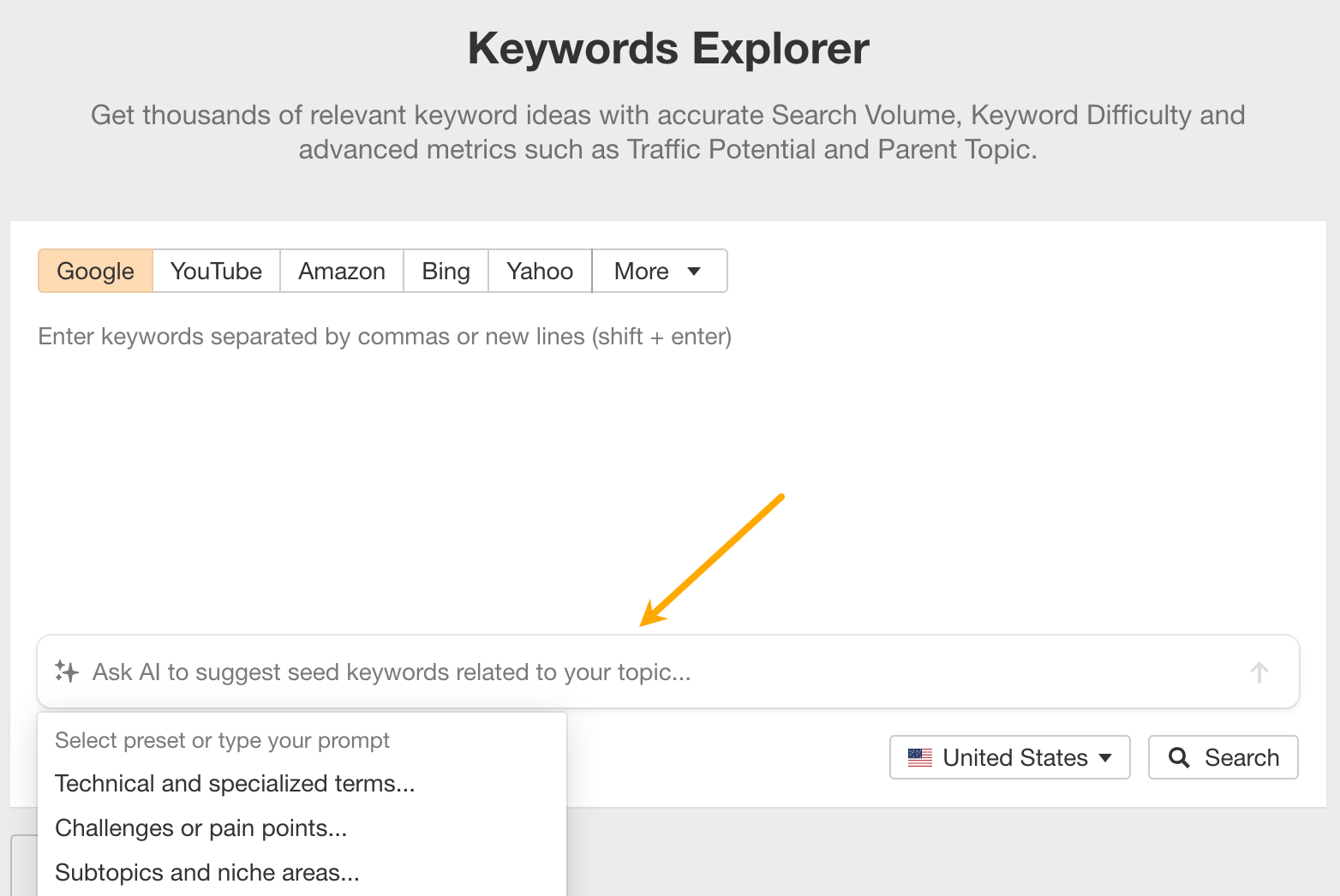

Next, make sure you’ve set up the country in which you’ll want to rank and hit “Search”.


After hitting the “Search” button, go to the Matching terms report. You will see a big list of keywords.


The list you’ll get will be quite raw — not all keywords will be equally good and the list will likely be too big to manage. Next steps are all about refining the list because we’ll be looking for target keywords — the keywords that will become the topic of your content.
2. Refine the list and cluster
The next step is to refine your list using filters.
Some useful basic filters are:
- KD (Keyword Difficulty): how difficult it would be to rank on the first page of Google for a given keyword.
- Traffic potential: traffic you can get for ranking #1 for that keyword and other relevant keywords (based on the page that currently ranks #1).
- Lowest DR (Domain Rating): plug in the DR of your site to see keywords where another site with the same DR already ranks in the top 10. In other words, it helps to find “rankable” keywords.
- Target: one of the main use cases is excluding keywords you already rank for.
- Include/Exclude: see keywords that contain specific words to increase relevancy/hide keywords with irrelevant words.
For example, here’s how to find potentially rankable keywords with traffic potential above 300 monthly visits. Go to the Matching terms report in Keywords Explorer and set filters: keyword difficulty filter (KD) to your site’s Domain Rating, Traffic potential, and Volume filters to a minimum of 300.


Clustering is another step to refine your list. It shows you if there is another keyword you could target to get more traffic (aka parent topic). At the same time, it shows which keywords most likely belong on the same page.
For example, here are some clusters distilled from low-competition topics about marketing.
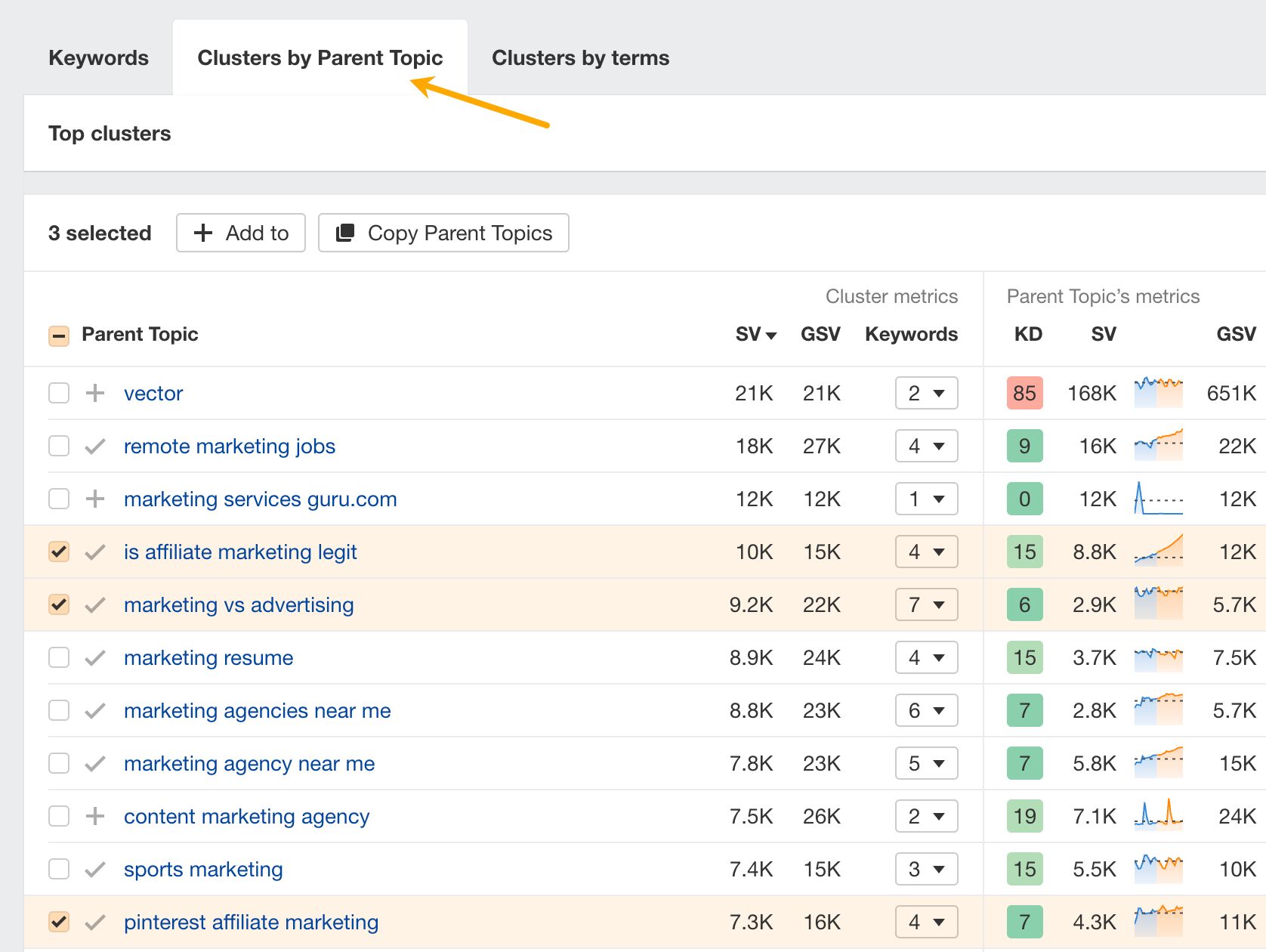

Pro tip
Take keyword trends into account when choosing keywords.
For example, the keyword “is affiliate marketing legit” is at 8.8k monthly search volume right now, but based on our forecast in Keywords Explorer (the orange part of the chart), if it continues its current growth rate it should be more than triple next year.


The graphs will also show you if the search volume is affected by seasonality (fluctuations in search volume throughout different times of the year).
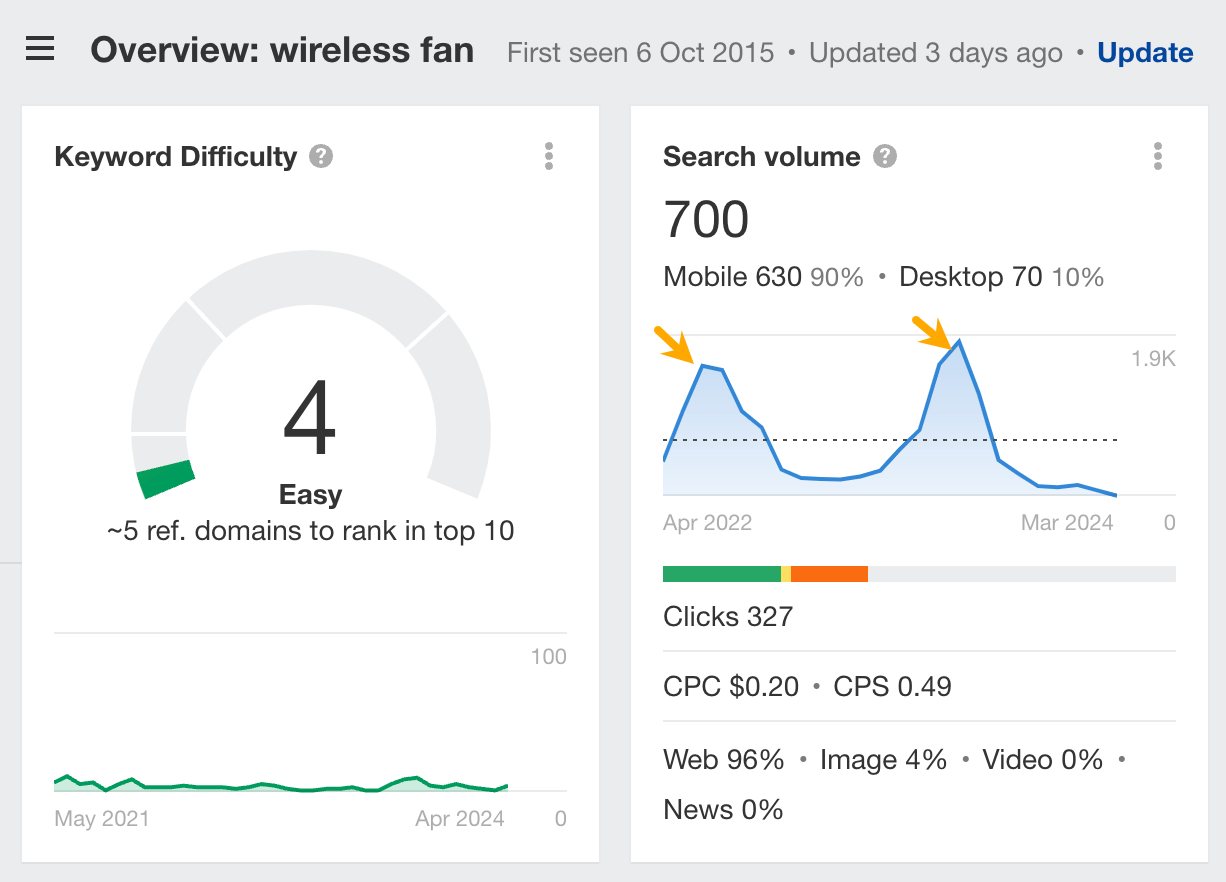

4. Identify search intent and determine value for your site
Before investing time in content, make sure you can give searchers what they want and that the keywords will attract the right kind of audience.
To identify the type of page you need to create to satisfy searchers, look at the top-ranking pages to see what purpose they serve (are they more informational or commercial), or simply use the Identify intents AI feature in Keywords Explorer.


So, for example, if the top-ranking pages are ecommerce pages and you’re not offering products on your site, it’s going to be very hard to rank.
Then, ask yourself if visitors attracted by a keyword will be valuable to your business — whether they’re likely to subscribe to your newsletter or make a purchase. At Ahrefs, we use a business potential score to evaluate this.


Finally, if a keyword checks all boxes, add it to a keyword list.


Now you’ve got a list of relevant, valuable target keywords with traffic potential ready for content creation. You can repeat the process as many times as you like with different seed keywords or different filters and find new ideas.
There’s one more great source of keywords — competitors.
5. Enrich the list with your competitors’ keywords
In this step, we’ll do a content gap analysis to find keywords your competitors already rank for, but you don’t.
First, let’s find your competitors.
- Enter your domain in Ahrefs’ Site Explorer and go to the Organic competitors report.
- Select the most relevant competitors and click on Copy (this copies URLs — we’ll use them in another tool).
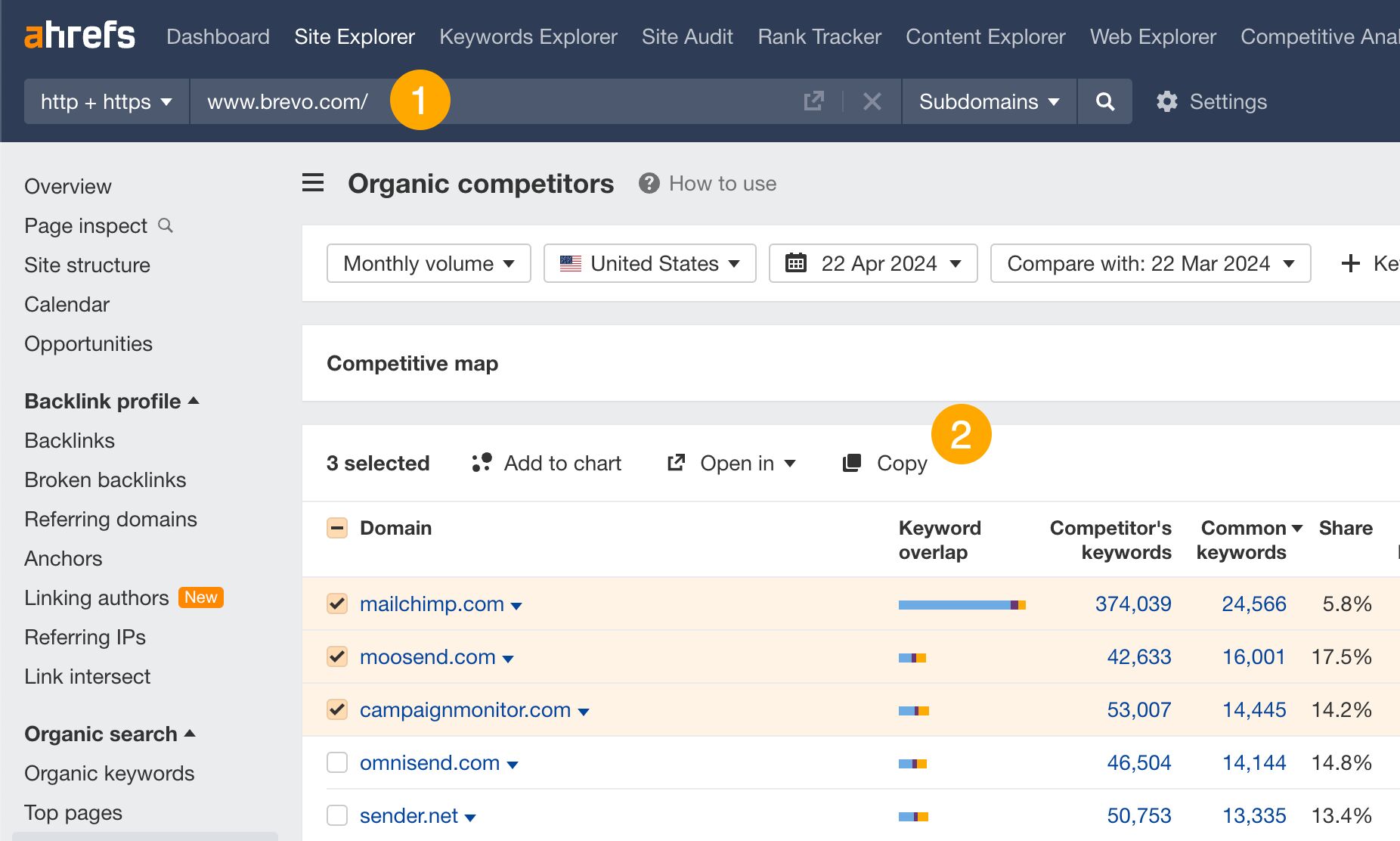

Next, we’ll see which keywords you’re missing.
- Go to Ahrefs’ Competitive Analysis tool, paste the previously copied URLs, enter your domain on top and hit Show keyword opportunities.


- In the Content gap report, use filters to refine the report.
- Select keywords and add them to your list.
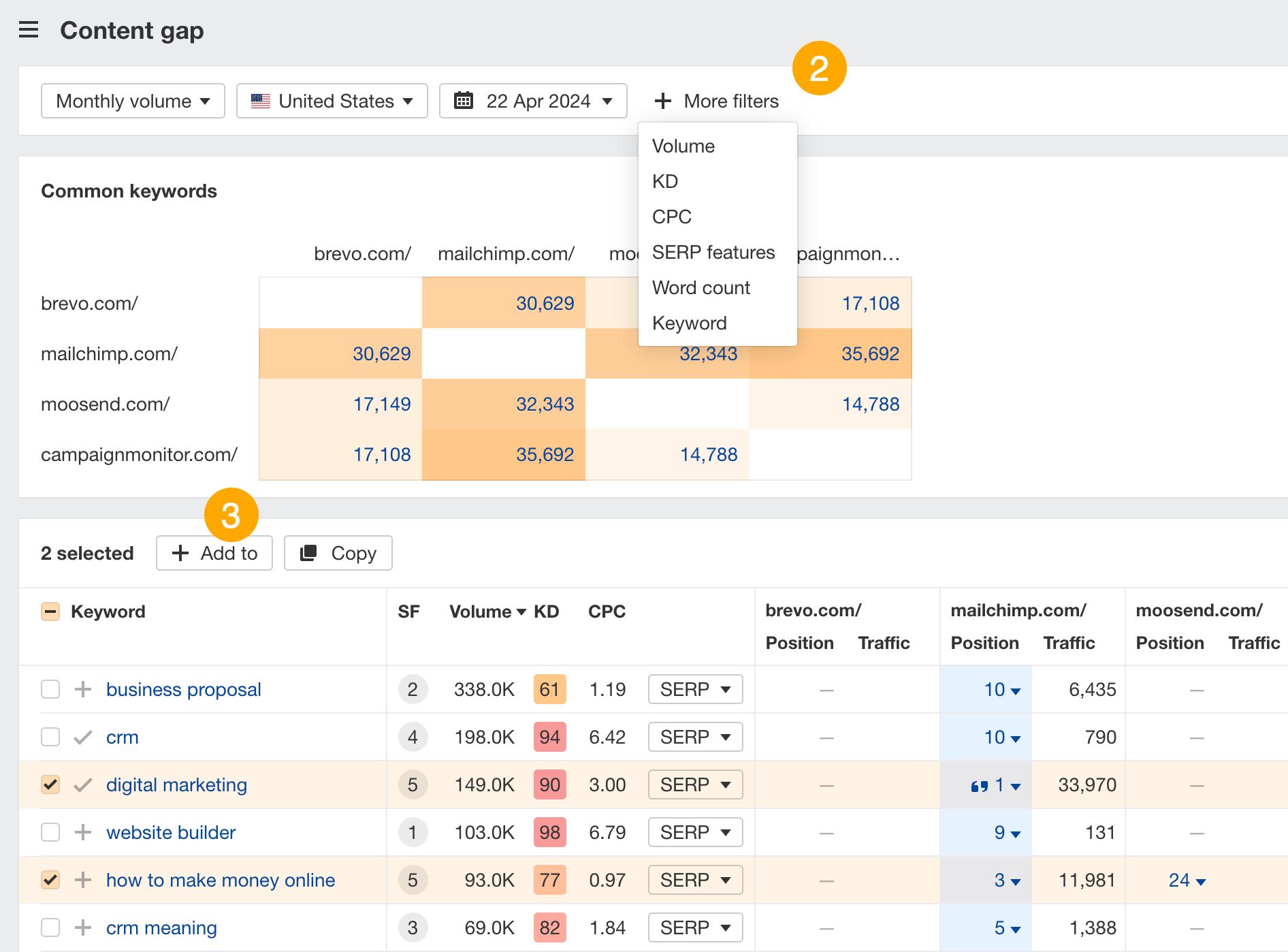

Pro tip
If you stumble across two similar keywords there’s an easy way to determine if they belong on the same page.
- Enter the keyword in Keywords Explorer.
- Scroll to SERP overview, click Compare with, and enter the keyword to compare with.


- Fewer common results and low SERP (Search Engine Result Page) similarity mean separate pages should target the two keywords.


Once you have your target keyword, you can include it in relevant places in your on-page content, including:
- Key elements of search intent (content type, format, and angle).
- URL slug.
- Title and H1.
- Meta description.
- Subheadings (H2 – H6).
- Main content.
- Anchor text for links.
And, just so we’re on the same page, the target keyword is the topic of the content and the main keyword you’ll be optimizing for and tracking later on.
Use the target keyword to determine the search intent
Search intent is the reason behind the search. Understanding it tells you what users are looking for and what you need to deliver in your content.
To identify search intent, look at the top-ranking results for your target keyword on Google and identify the three Cs of search intent:
- Content type – What is the dominating type of content? Is it a blog post, product page, video, or something else? If you’ve done that during the keyword research phase (highly recommended), only two elements to go.
- Content format – Some common formats include how-to guides, list posts, reviews, comparisons, etc.
- Content angle – The unique selling point of the top-ranking points, e.g., “best,” “cheapest,” “for beginners,” etc. Provides insight into what searchers value in a particular search.
For example, most top-ranking pages for “avocado seed” are blog posts serving as how-to guides for planting the seed. The use of easy and simple angles indicates that searchers are beginners looking for straightforward advice.
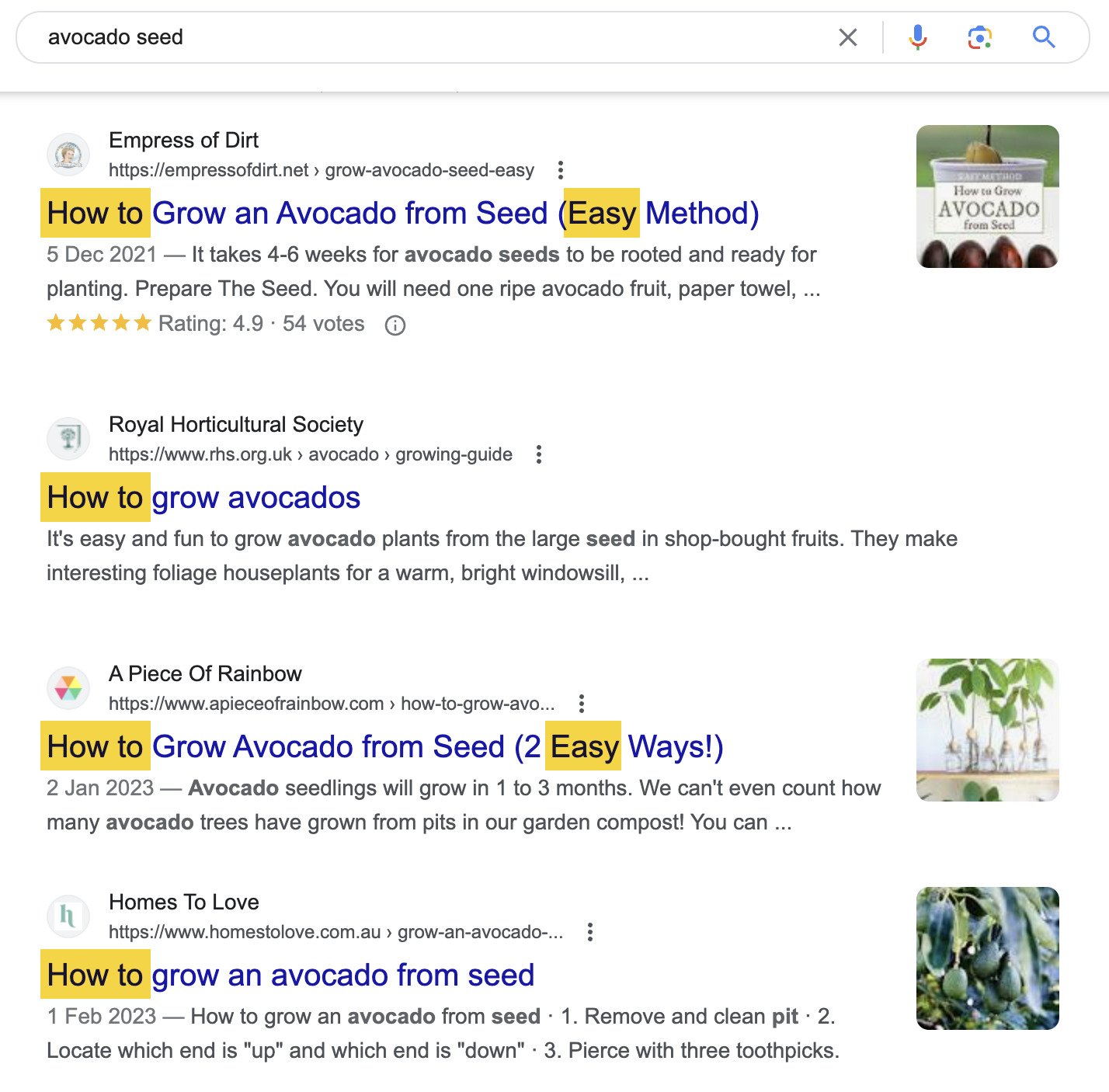

Use the target keyword in the URL slug
A URL slug is the part of the URL that identifies a specific page on a website in a form readable by both users and search engines.
If you look at the URL of the page you’re on, that will be the last part, “how-to-use-keywords-seo”.
https://ahrefs.com/blog/how-to-use-keywords-seoGoogle says to use words that are relevant to your content inside page URLs (source). Usually, the easiest way to do that is to set your target keyword in the slug part of the URL.


Use the target keyword in the title and match it with the H1 tag
A title tag is a bit of HTML code used to specify the title of a webpage.
<title>How to Use Keywords for SEO: A-Z Guide For Beginners</title>The H1 tag is an HTML heading that’s most commonly used to mark up a web page title.
<h1>How to Use Keywords for SEO: A-Z Guide For Beginners</h1>Both are very important to Google and searchers. Since they both indicate what the page is about, you can just match them, like I did in this article.
Titles help Google understand the context of a page. What’s more, even a slight improvement to your title can improve your rankings.
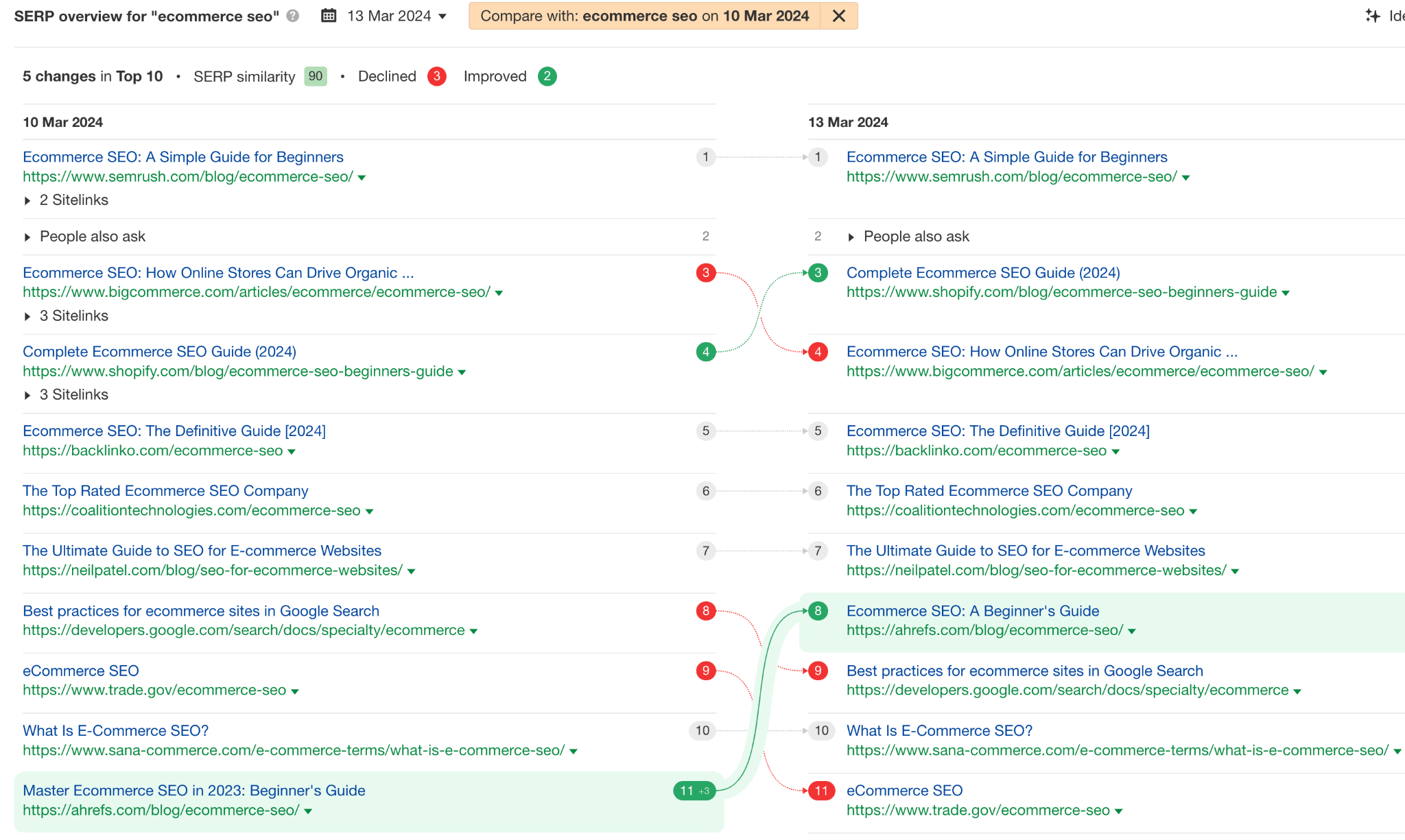

Google advises focusing on creating good titles, which should be “unique to the page, clear and concise, and accurately describe the contents of the page” (source). It’s hard to think of a better way to accurately describe the contents other than using the target keyword.
If it makes sense for the title, aim for an exact match of the keyword. But if you need to insert a preposition or break the phrase, this won’t make Google think your page is less relevant. Google understands close variations of the keyword really well, so there’s no need to stuff in similar keywords, misspellings, etc.
To illustrate, my old article on how to see keywords that Google Analytics won’t show ranks #1 for many variations of the phrase in the title.




Use the keyword in meta description
However, don’t write meta descriptions solely for Google; Google rewrites them more than half of the time (study) and doesn’t use them for ranking purposes. Instead, focus on crafting meta descriptions for searchers.
These descriptions appear in the SERPs, where users can read them. If your description is relevant and compelling, it can increase the likelihood of users clicking on your link.
Including your target keyword in the meta description is usually natural. For instance, consider the description of the article mentioned earlier. Incorporating the keyword into the sentences simply provides a comprehensive way to describe the issue.
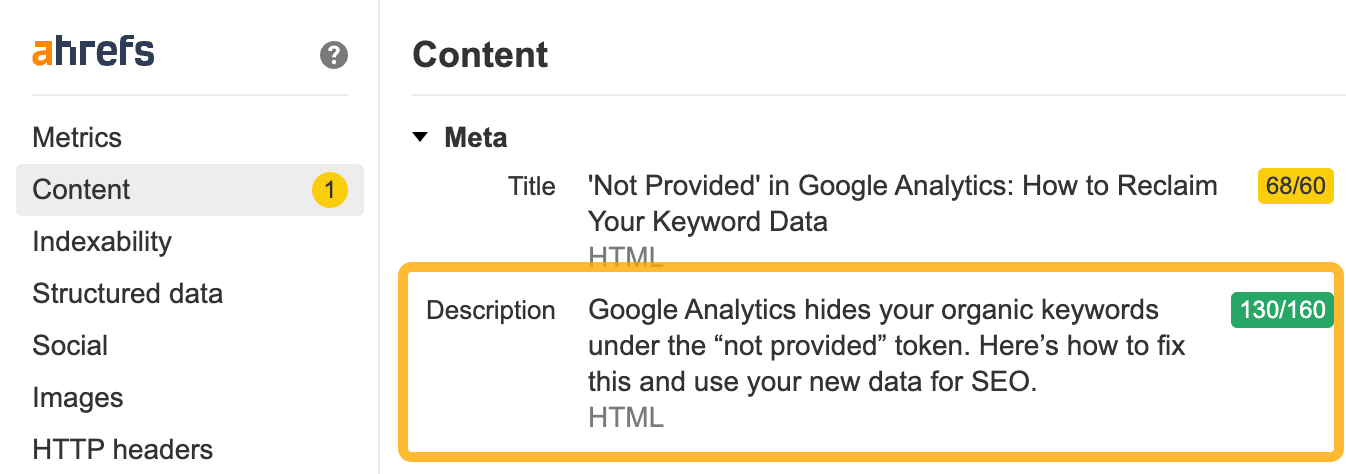

Use the target keyword to find secondary keywords
Secondary keywords are any keywords closely related to the primary keyword that you’re targeting with your page.
You can find them through your primary keyword and use them as subheadings (H2 to H6 tags) and talking points throughout the content. Here’s how.
Go to Keywords Explorer and plug in your target keyword. From there, head on to the Related terms report and toggle between:
- Also rank for: keywords that the top 10 ranking pages also rank for.
- Also talk about: keywords frequently mention by top-ranking articles.
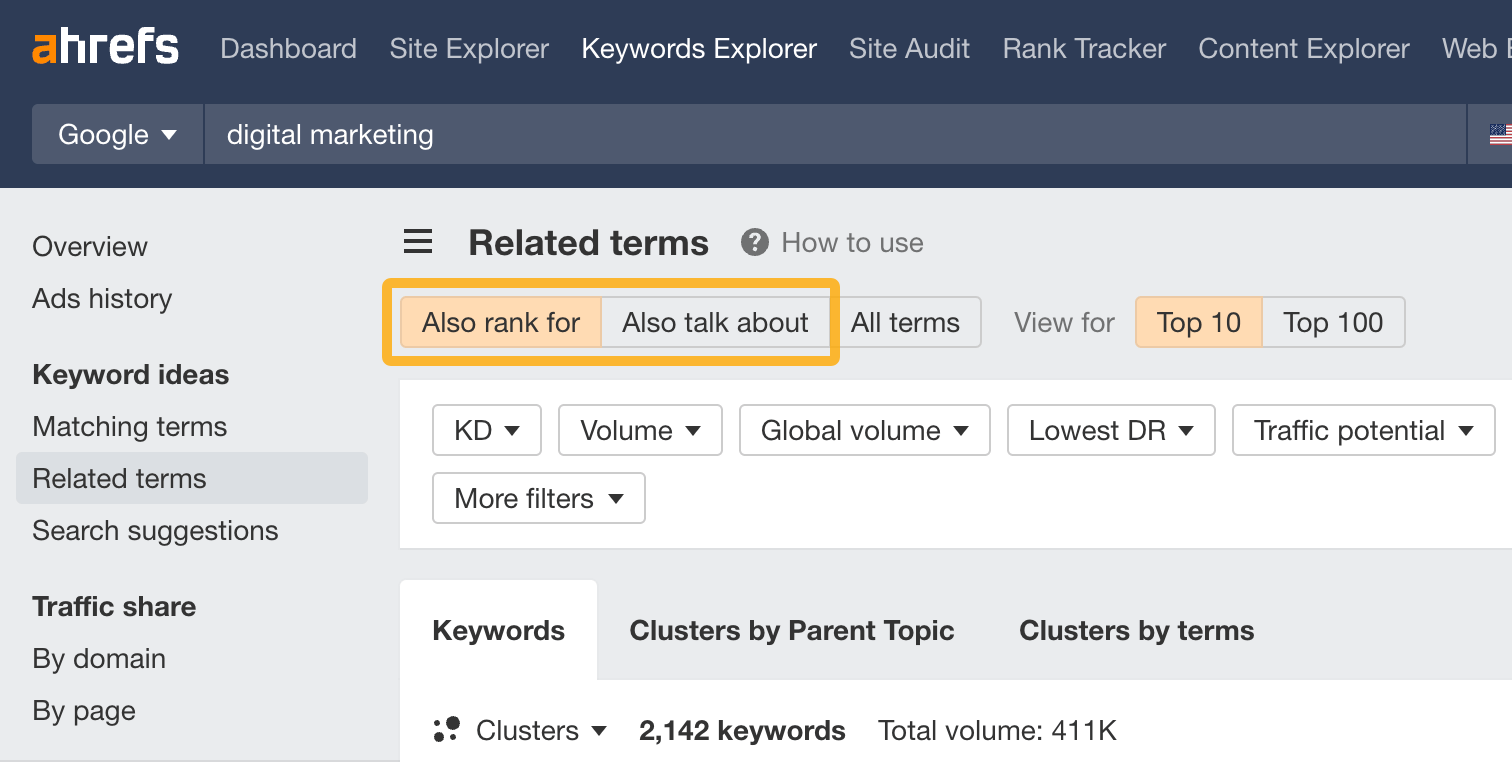

Now, to know how to use these keywords in your text, just manually look at the top ranking pages and see how and where they cover the keywords.
For example, looking at one of the top articles for “digital marketing”, we can see right away that some of the most important aspects are the definition, a template and importance. You can use the free Ahrefs SEO Toolbar to break down the structure of any page instantly.


Another place you can look for inspiration is the People Also Ask Box in the SERPs. Use it to find words and subtopics that may be worth adding to the article.


Pro tip
Optimizing an existing article?
Use the Content Gap tool to find subtopics you may be missing. The tool shows keywords that your competitors’ pages rank for, and your page doesn’t.
- Go to Keywords Explorer and enter your target keyword.
- Scroll down to the SERP overview, select a few top pages, and click Open in Content Gap.


- In Content Gap, click on Targets and add the page you’re optimizing in the last field.
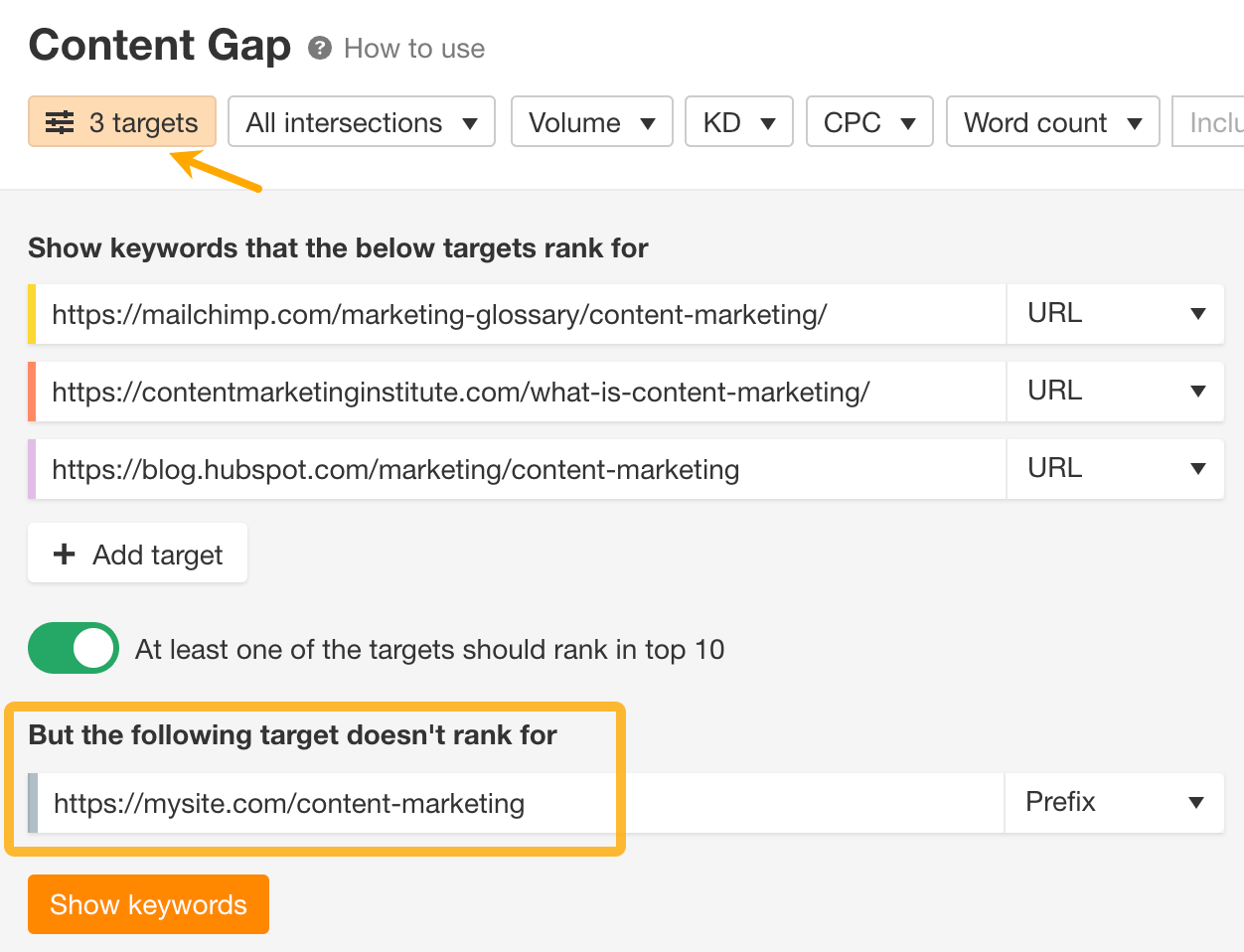

Use primary and secondary keywords in the main content
To rank high on search engines, it’s important to include your keywords in your text. Even though Google is good at understanding similar words and variations, it still helps to use the specific keywords people might search for. Google explains that in their short guide to how search works:
The most basic signal that information is relevant is when content contains the same keywords as your search query. For example, with webpages, if those keywords appear on the page, or if they appear in the headings or body of the text, the information might be more relevant.
When writing, it’s important to incorporate keywords naturally. Start your content with the most relevant information that people are likely to search for. This ensures that key points are immediately visible to your readers and search engines.


If you have a secondary keyword that’s less critical but still relevant, consider giving it a dedicated section. This approach allows you to explore the topic in detail, rather than briefly mentioning it at the end of your content.


However, avoid overemphasizing the frequency of your keywords. Effective SEO involves more than just repeating keywords. If SEO were simply about keyword density, it would be straightforward, but such strategies don’t lead to long-term success and can make your content feel spammy.
For instance, if ‘content strategy’ is a central theme of your discussion and you mention it only once, Google might perceive your content as incomplete. On the other hand, stuffing your article with the term ‘content strategy’ more than necessary won’t outperform your competitors and could potentially lead to your site being flagged as spam.
Use the target keyword in link anchor text and/or surrounding text
The anchor text or link text is the clickable text of an HTML hyperlink.
Google uses anchors to understand the page’s context. There even seems to be a consensus that anchor text is a ranking factor, although, according to our study, it is likely a weak one.
In situations like these, it’s just best to stick with Google’s advice:
Good anchor text is descriptive, reasonably concise, and relevant to the page that it’s on and to the page it links to. It provides context for the link, and sets the expectation for your readers. (…)
Remember to give context to your links: the words before and after links matter, so pay attention to the sentence as a whole.
So use the target keyword in the anchor text and or surrounding text but keep it natural — add only on pages that are related to the page you’re linking to and use text that will help the readers understand where and why you’re linking.


Rank tracking refers to monitoring the positions of a website’s pages in search engine results for specific keywords.
It’s pretty much an automated process; everything can be handled by a tool like Ahrefs’ Rank Tracker. No need to check rankings manually and note them down in a spreadsheet.
If you have a keyword list ready, all you need to do is add that list to Rank Tracker.
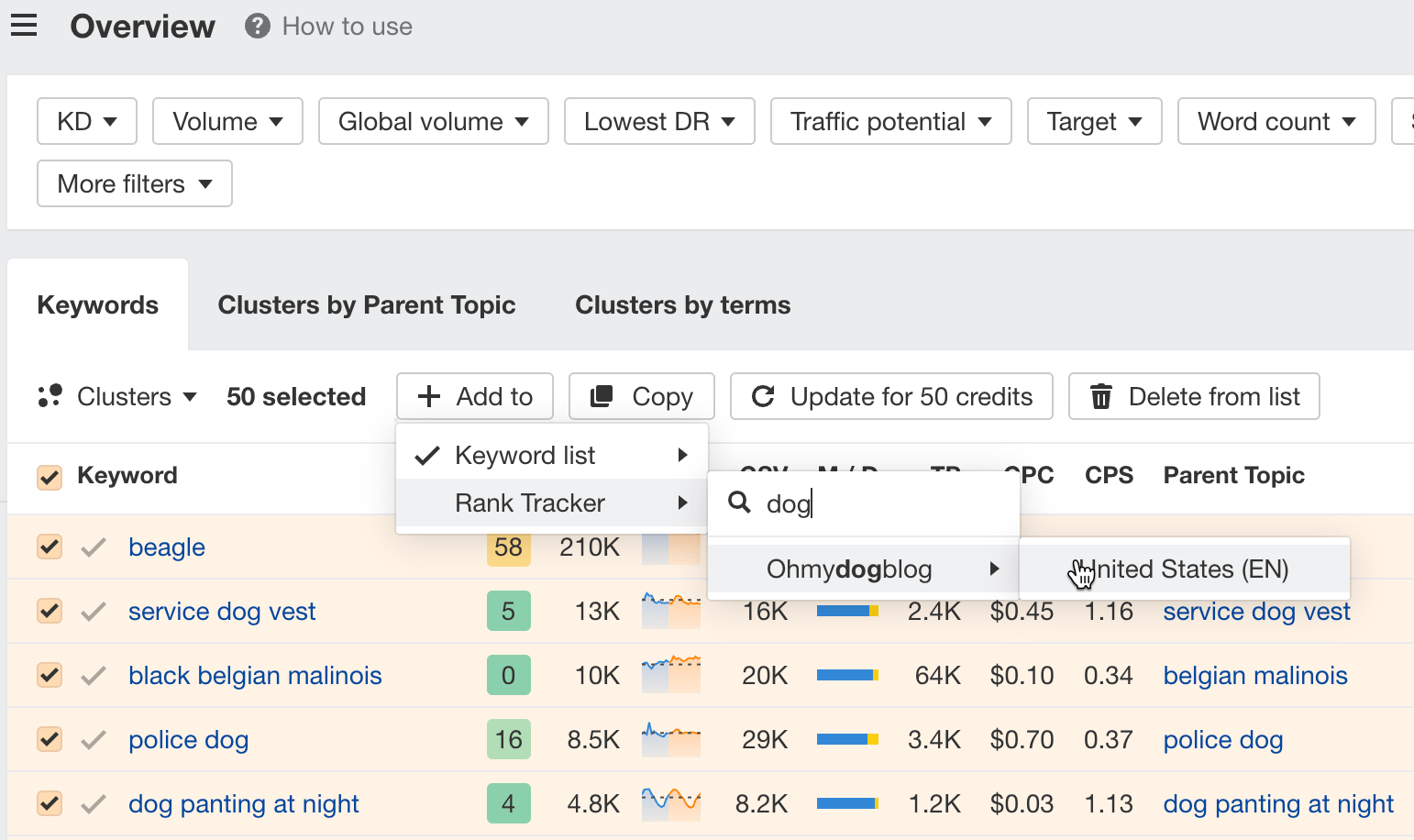

The keywords will appear in Rank Tracker’s Overview report.


Another way to add keywords is to hit Add keywords in the top right corner (best for adding single keywords or importing a list from a document).


Now to compare your performance against competitors, just go to the Competitors report. The metric I recommend tracking is SOV (Share of Voice). It shows how many clicks go to your pages compared to competitors.
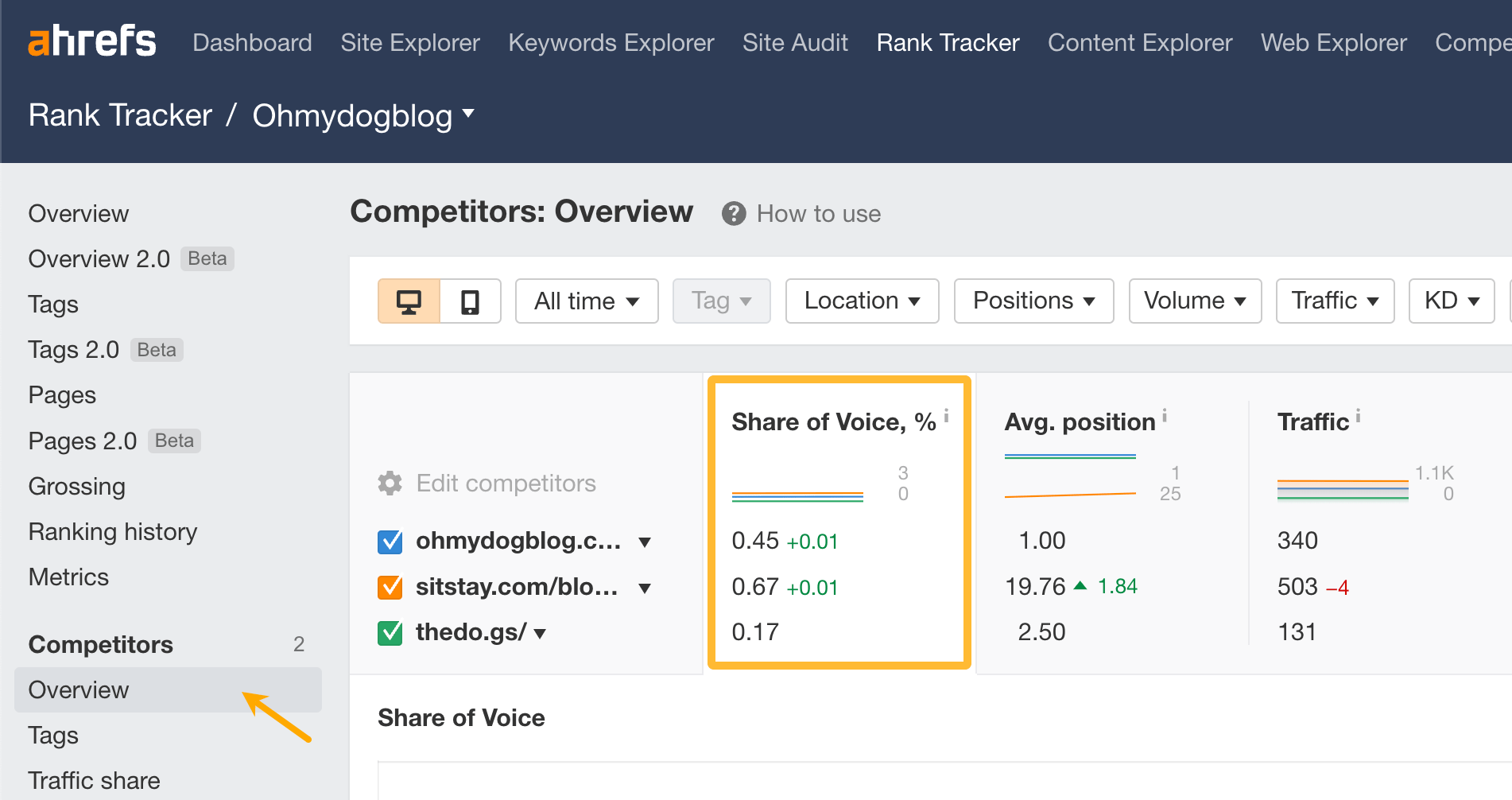

One of the key advantages of SOV is that it accounts for fluctuations in search volume trends. Therefore, if you notice a decrease in traffic but maintain a high SOV, it indicates that the drop is due to a decrease in the overall popularity of the keywords, not a decline in your SEO effectiveness.
But not only can you track your competitors’ keywords, you can also monitor them. Use a tool like Ahrefs Alerts to get notifications whenever your competitors started working for a new keyword.
Just to go Alerts tool in Ahrefs and fill in the details.
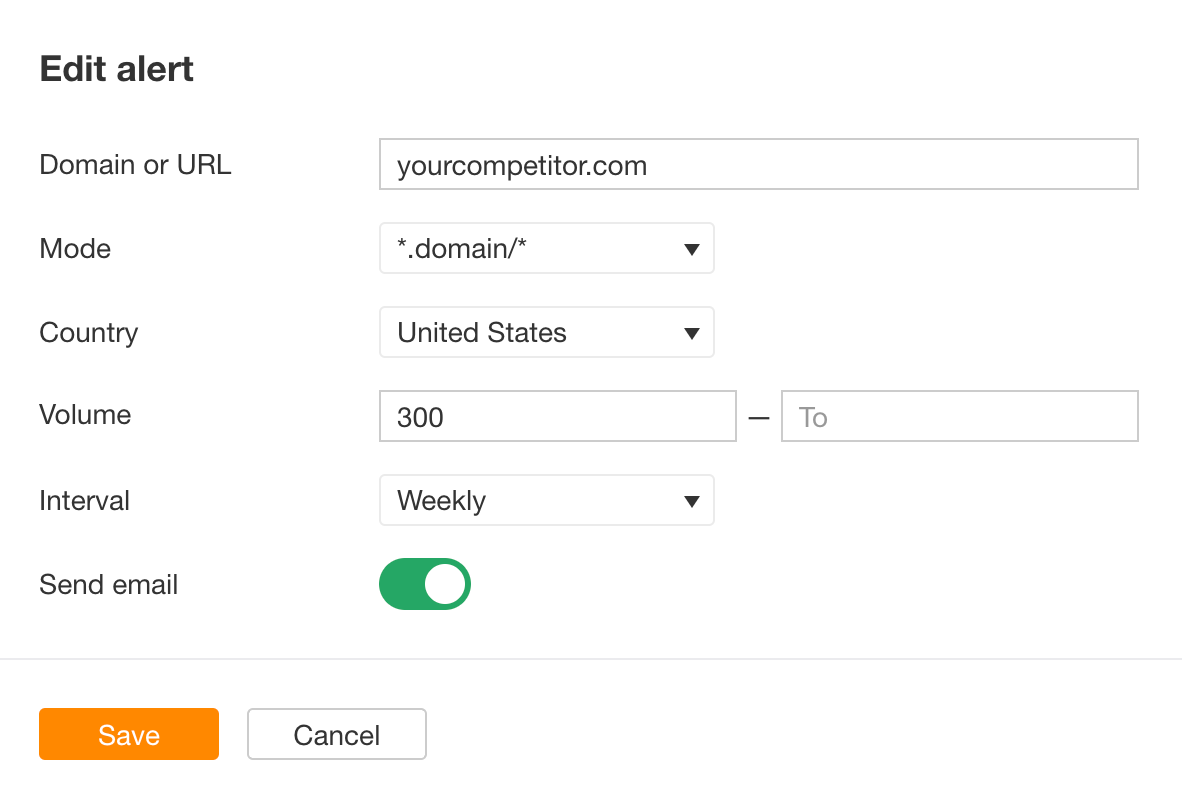

There’s even more you can do with keywords and a bit more you should know to avoid some common mistakes.
1. Use keywords to find guest blogging opportunities
Guest blogging is the practice of writing and publishing a blog post on another person or company’s website.
It’s one of the most popular link building tactics with a few other benefits like exposure to a new, targeted audience.
Here’s how to find relevant, high-quality sites to pitch:
- Go to Ahrefs’ Content Explorer.
- Enter a broad keyword or phrase related to your niche.
- Select In title from the drop-down menu.
- Run the search.
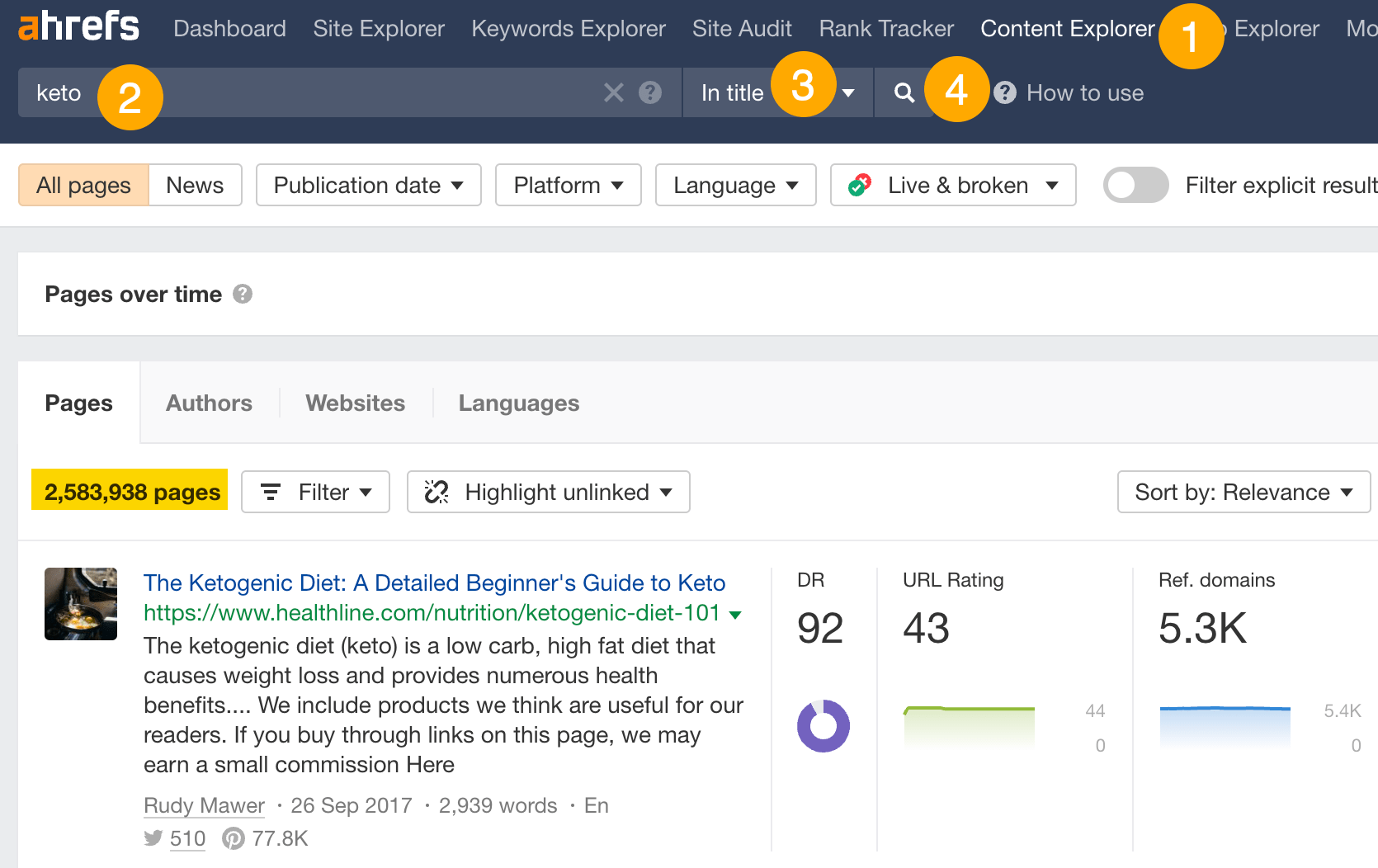

Next, refine the list by applying these filters:
- Domain Rating (DR) from 30 to 60.
- Click the One page per domain filter.
- Click the Exclude homepages filter.
- Click the Exclude subdomains filter.
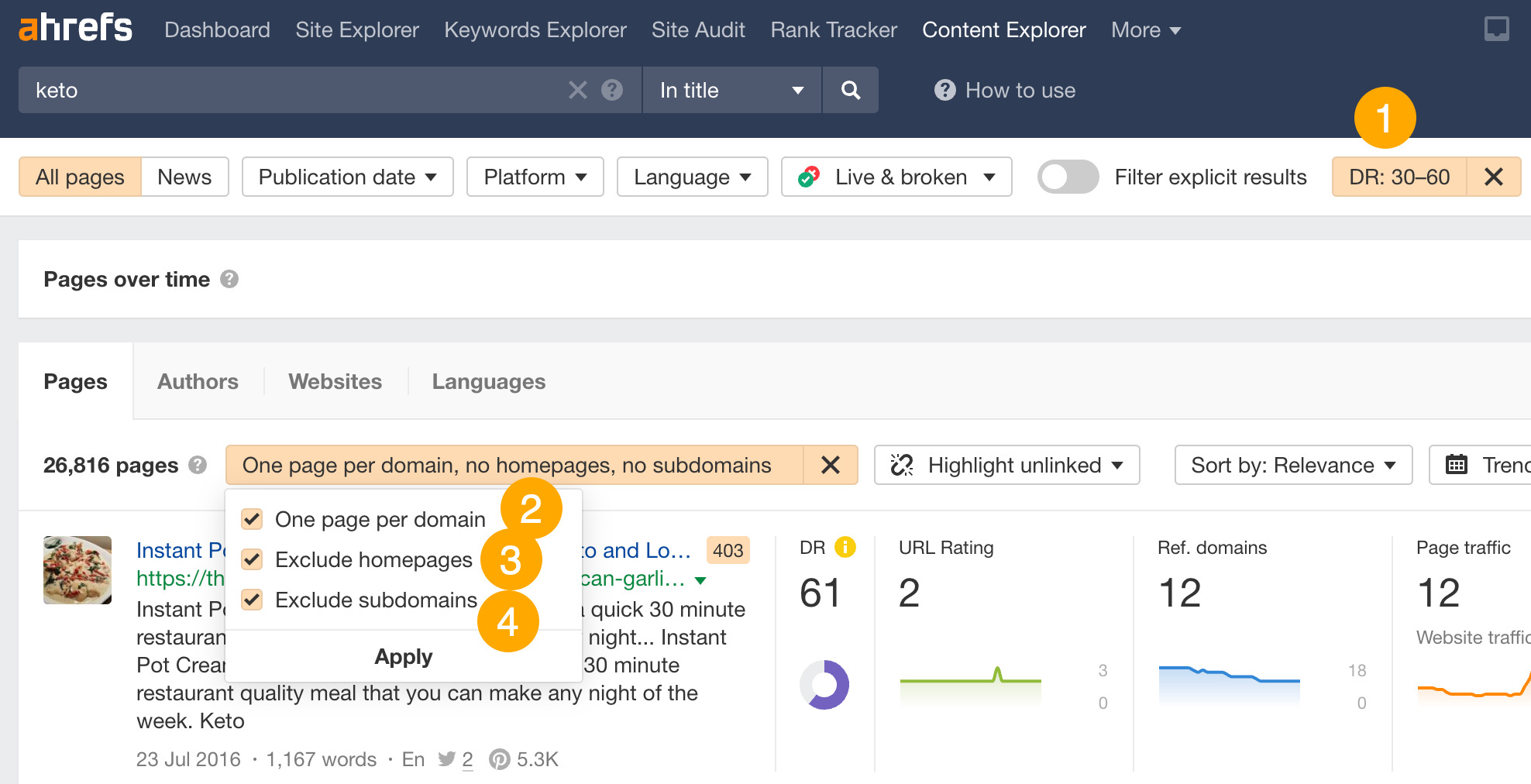

Finally, click on the Websites tab to see potential websites you could guest blog for.
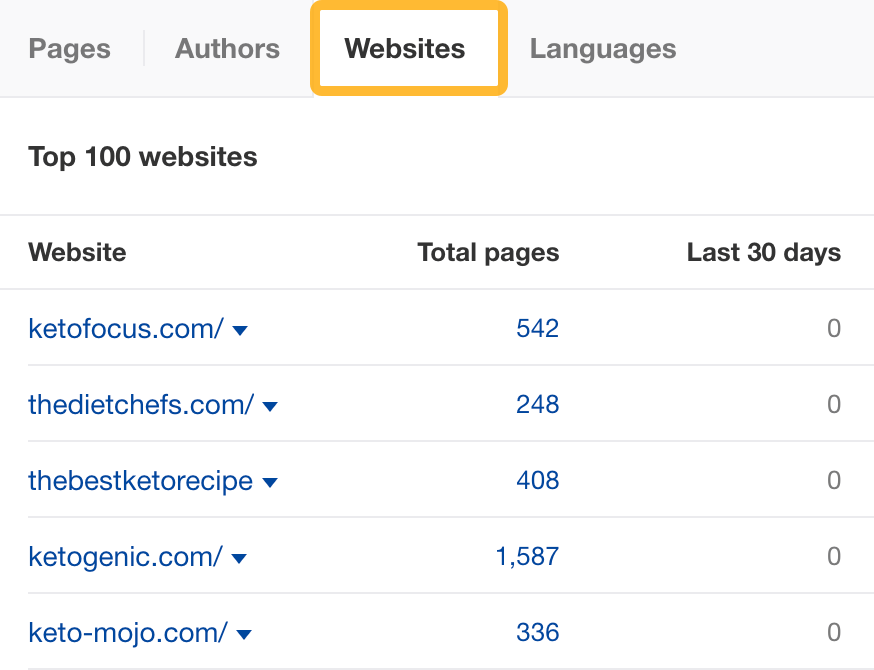

2. Use keywords to find internal link opportunities
Internal links take visitors from one page to another on your website. Their main purpose is to help visitors easily navigate your website, but they can also help boost SEO by aiding the flow of link equity.
Finding new internal link opportunities is also a time-consuming process if done manually, but you can identify them in bulk using Ahrefs’ Site Audit. The tool takes the top 10 keywords (by traffic) for each crawled page, then looks for mentions of those on your other crawled pages.
Click on the Internal link opportunities report in Site Audit.


You’ll see a bunch of suggestions on how to improve your internal linking using new links. The tool even suggests exactly where to place the internal link.


3. Use keywords to find link building opportunities
Link building is the process of getting other websites to link to pages on your website. Its purpose is to boost the “authority” of your pages in the eyes of Google and help your pages rank.
A good place to start is to pull up the top-ranking pages for your target keyword and research where they got their links from.
Put your keyword into Keywords Explorer and scroll down to the SERP overview. You’ll see the top-ranking pages and their number of backlinks (and linking domains).


Once you click on any of the backlink numbers, you’ll be redirected to a list of backlinks of a given page in Site Explorer.


From that point, the typical process involves identifying sites with the highest potential to boost your SEO and contacting their owners if you think they’d be willing to link to your content. We’re covering the details of this process and everything else you need to know to start with link building in this guide.
4. Avoid common keyword pitfalls
Four big don’ts of using keywords.
- Don’t use the same keyword excessively on a page. Repeating a keyword too frequently within a single page can lead to keyword stuffing, which is treated as spam by Google.
- Don’t use the same focus keyword across multiple pages. Each page on your website should have a unique focus keyword. Using the same keyword across multiple pages can lead to keyword cannibalization, where pages compete against each other in search results.
- Don’t sacrifice quality content for keyword usage. While keywords are essential for SEO, prioritize high-quality, informative content above all else. Don’t make your content read unnatural or too long by cramming in keywords. This won’t help you rank and will decrease content quality.
- Don’t use keywords just for the sake of using them. This means two things. First, don’t target keywords not related to your website or business — this will only bring you useless traffic. Second, don’t try to hit some keyword frequency goal which is often suggested by content optimization tools by just mentioning the keyword without any substance — SEO doesn’t work that way anymore.
Final thoughts
This article focused on general SEO for text-based content. For using keywords in other types of content and SEO, see these guides:
SEO
Google Launches New ‘Saved Comparisons’ Feature For Analytics

Google announced a new tool for Analytics to streamline data comparisons.
The ‘saved comparisons’ feature allows you to save filtered user data segments for rapid side-by-side analysis.
Google states in an announcement:
“We’re launching saved comparisons to help you save time when comparing the user bases you care about.
Learn how you can do that without recreating the comparison every time!”
We’re launching saved comparisons to help you save time when comparing the user bases you care about. Learn how you can do that without recreating the comparison every time! → https://t.co/29nN2MiPtm pic.twitter.com/r8924rAT05
— Google Analytics (@googleanalytics) May 8, 2024
Google links to a help page that lists several benefits and use cases:
“Comparisons let you evaluate subsets of your data side by side. For example, you could compare data generated by Android devices to data generated by iOS devices.”
“In Google Analytics 4, comparisons take the place of segments in Universal Analytics.”
Saved Comparisons: How They Work
The new comparisons tool allows you to create customized filtered views of Google Analytics data based on dimensions like platform, country, traffic source, and custom audiences.
These dimensions can incorporate multiple conditions using logic operators.
For example, you could generate a comparison separating “Android OR iOS” traffic from web traffic. Or you could combine location data like “Country = Argentina OR Japan” with platform filters.
These customized comparison views can then be saved to the property level in Analytics.
Users with access can quickly apply saved comparisons to any report for efficient analysis without rebuilding filters.
Google’s documentation states:
“As an administrator or editor…you can save comparisons to your Google Analytics 4 property. Saved comparisons enable you and others with access to compare the user bases you care about without needing to recreate the comparisons each time.”
Rollout & Limitations
The saved comparisons feature is rolling out gradually. There’s a limit of 200 saved comparisons per property.
For more advanced filtering needs, such as sequences of user events, Google recommends creating a custom audience first and saving a comparison based on that audience definition.
Some reports may be incompatible if they don’t include the filtered dimensions used in a saved comparison. In that case, the documentation suggests choosing different dimensions or conditions for that report type.
Why SEJ Cares
The ability to create and apply saved comparisons addresses a time-consuming aspect of analytics work.
Analysts must view data through different lenses, segmenting by device, location, traffic source, etc. Manually recreating these filtered comparisons for each report can slow down production.
Any innovation streamlining common tasks is welcome in an arena where data teams are strapped for time.
How This Can Help You
Saved comparisons mean less time getting bogged down in filter recreation and more time for impactful analysis.
Here are a few key ways this could benefit your work:
- Save time by avoiding constant recreation of filters for common comparisons (e.g. mobile vs desktop, traffic sources, geo locations).
- Share saved comparisons with colleagues for consistent analysis views.
- Switch between comprehensive views and isolated comparisons with a single click.
- Break down conversions, engagement, audience origins, and more by your saved user segments.
- Use thoughtfully combined conditions to surface targeted segments (e.g. paid traffic for a certain product/location).
The new saved comparisons in Google Analytics may seem like an incremental change. However, simplifying workflows and reducing time spent on mundane tasks can boost productivity in a big way.
Featured Image: wan wei/Shutterstock
-
SEARCHENGINES5 days ago
Daily Search Forum Recap: May 3, 2024
-

 MARKETING5 days ago
MARKETING5 days agoHow Tagging Strategies Transform Marketing Campaigns
-

 MARKETING7 days ago
MARKETING7 days agoLet’s Start Treating Content More Like We Treat Code
-
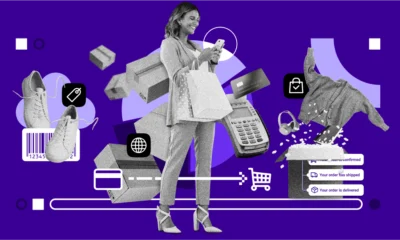
 MARKETING6 days ago
MARKETING6 days agoTinuiti Recognized in Forrester Report for Media Management Excellence
-
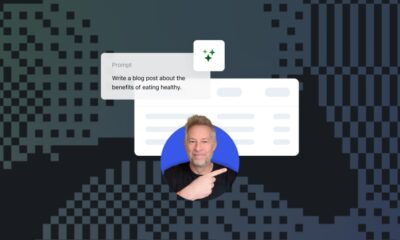
 WORDPRESS6 days ago
WORDPRESS6 days agoThe Top 5 AI-Powered Tools for WordPress Creatives – WordPress.com News
-

 PPC6 days ago
PPC6 days agoStandard Performance Max vs Performance Max for Retail
-
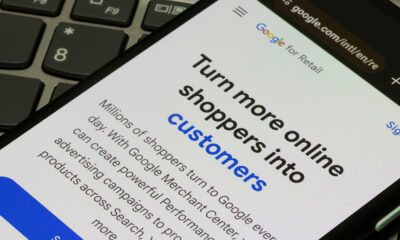
 SEO6 days ago
SEO6 days agoGoogle Performance Max For Marketplaces: Advertise Without A Website
-

 SEARCHENGINES4 days ago
SEARCHENGINES4 days agoThe Industry Mourns The Loss Of Mark Irvine


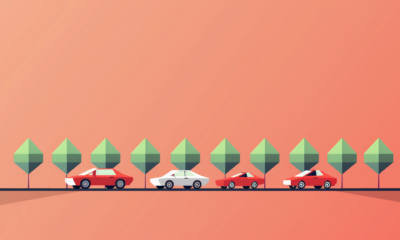





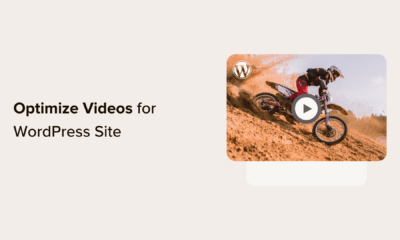

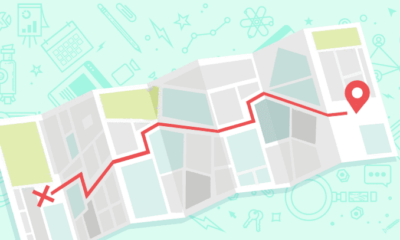

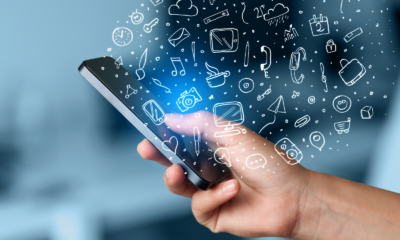



You must be logged in to post a comment Login